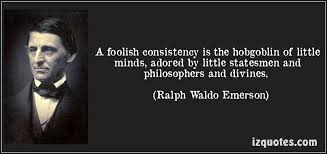 Welcome to O.D. Fridays at DonorDreams blog. Every Friday for the foreseeable future we will be looking at posts from John Greco’s blog called “johnponders ~ about life at work, mostly” and applying his organizational development messages to the non-profit community.
Welcome to O.D. Fridays at DonorDreams blog. Every Friday for the foreseeable future we will be looking at posts from John Greco’s blog called “johnponders ~ about life at work, mostly” and applying his organizational development messages to the non-profit community.
In a post titled “Adoring Hobgoblins,” John dissects the following quotation from Ralph Waldo Emerson: “A foolish consistency is the hobgoblin of little minds, adored by little statesmen and philosophers and divines.” He explains to readers that consistency can be a good thing, but it suddenly becomes a bad thing when it interferes with our good judgement and results in poor actions.
Reading this Emerson quotation set my mind down two different paths this morning. So, what the heck? Let’s go down two roads this morning.
Don’t have a written resource development plan?
It is a best practice in my book to engage board members and fundraising volunteers every year in a process that results in a written resource development plan (aka fundraising plan). It should provide definition and explanation to the revenue side of your agency budget.
Do you know how many non-profit organizations — big and small — with which I’ve worked that don’t do this? OMG . . . it is a crazy BIG number.
So, what do those organizations do if they aren’t operating with a resource development plan?
Yep . . . you guessed it. They are relying on “consistency” and sometimes it is “foolish consistency“.
For example, one organization I worked with many years ago didn’t see the need to develop an annual fundraising plan and pointed to their special event fundraisers as something they’ve been doing forever. One of their events had been run for more than two decades.
Their conclusion . . . “why waste time — that we don’t have — on writing this stuff down, especially when it hasn’t changed in two decades?”
 Well, huh? Let me see here. Every good planning process begins with an assessment /evaluation which springboards off into goal setting, strategy development and action planning. If the organization I just referenced hadn’t been so “foolishly consistent,” they would’ve seen the following:
Well, huh? Let me see here. Every good planning process begins with an assessment /evaluation which springboards off into goal setting, strategy development and action planning. If the organization I just referenced hadn’t been so “foolishly consistent,” they would’ve seen the following:
- The revenue from their signature event plateaued 13 years ago and has been in steady decline ever since
- Many of the people attending their event sit at corporate tables, and they do so anonymously. There were no strategies in place to capture individual donor data, which means the cultivation effect of that event is lost on those people.
- Many of the individuals who were die-hard supporters of that event were likely capable and willing to contribute more, but there were no upgrade strategies in place. So, money was being left on the table.
- There were hundreds of donors over a 20 year time span who had attended this event a few times and then stopped. There were no strategies to re-engage those lapsed donors either in the event or other places in the agency’s resource development plan.
If I’m not mistaken, these four bullet points are the personification of that “hobgoblin” in Emerson’s famous quotation. And, boy oh boy, what an ugly little hobgoblin it is.
I know that some people think of planning processes as a “foolish consistency“. I obviously DO NOT! In fact, I see it as just the opposite. A well-run planning process of any kind should:
- help your organization look at things differently
- keep a fresh perspective
- engage in dynamic brainstorming
- inspire change that keeps your agency’s growing
This brings me to the last portion of Emerson’s quotation “. . . adored by little statesmen and philosophers and divines“. I would love to add the words “board volunteers and agency staff“.
 The board members and executive director of the agency I reference in the example above certainly were “little“. I say this because their “foolish consistency” and unwillingness to do any assessment and planning had locked them into being a certain size. When you looked at their agency budget, they had brought in the same amount of revenue for the last 10 years.
The board members and executive director of the agency I reference in the example above certainly were “little“. I say this because their “foolish consistency” and unwillingness to do any assessment and planning had locked them into being a certain size. When you looked at their agency budget, they had brought in the same amount of revenue for the last 10 years.
Think about that for a moment. When you factor in inflation, this agency was contracting and raising less and less money every year. Foolish? Yes! Hobgoblins? Yes!! YES!! Little? Yes!!! Yes!!! Yes!!!
If your agency operates with a December 31st year-end fiscal year, then your budget construction process should be starting soon. If this is the case, then your resource development planning process should also be starting soon.
Do you need help with that planning process? If so, I know someone you should call who can help . . . you know who I mean. 😉
The other road referenced?
In the beginning of this blog post, I said John’s post centered on Ralph Waldo Emerson’s quotation set my mind down two different paths this morning.
When I first read John’s post, I immediately thought of how many times I’ve heard from non-profit board members, executive directors and fundraising professionals the following words:
“That’s not the way we do things around here”
Not only are these words (or other words that sound or mean the same thing) the equivalent of nails on a chalkboard, but they are downright poisonous to your non-profit organization.
I’ve run out of space, but luckily Seth Godin did a nice job of succinctly and eloquently addressing this issue on his blog. If you have 15 more seconds, then you really need to click-through and read Seth’s thoughts on these nine dangerous words.
Can you identify your agency’s “silly consistencies“? If so, what are they? Can you describe those hobgoblins? If so, what do they look like? Please scroll down and share your examples and thoughts as well as what you plan on doing about it in the comment box below. Why? Because we can all learn from each other.
Here’s to your health!
Erik Anderson
Founder & President, The Healthy Non-Profit LLC
www.thehealthynonprofit.com
erik@thehealthynonprofit.com
http://twitter.com/#!/eanderson847
http://www.facebook.com/eanderson847
http://www.linkedin.com/in/erikanderson847
